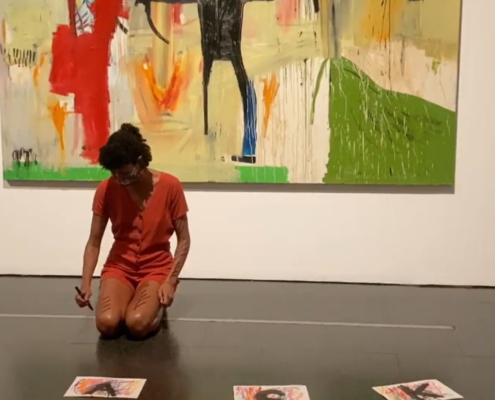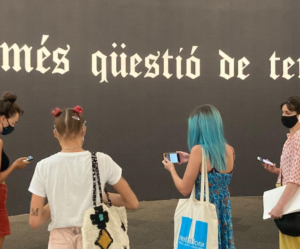The Contemporary Art Museum
/ the Contemporary Art School
——
Why include a Contemporary Art Museum as an active component in a Studio arts Program?
One of the most important missions of an art school like Metàfora is to show its students not only to make art, to talk about art and to reflect on it. It is central that, as promoters of contemporary art, we sometimes pull the students out of the studios and present them with the contemporary context, the art scene.
In our case, Barcelona’s art scene.
The fact that MACBA, Barcelona’s well reputed Museum of Contemporary Art, has opened its doors to Metàfora’s art students, has given us a great chance to broaden our horizon and dive into an large collection of Catalan and international art from the 1970’s to the present day, but also to let our students engage very physically and directly with the collection, as well as with the museum itself.
Jette Bjerg is co-founder of Metàfora and director of its Studio Arts Programs
“Make MACBA Yours”
Metàfora has recently included a number of classes directly onsite, at the museum itself. As part of our studio arts program, we organize periodical visits to the temporary art exhibitions and the permanent collection, but also a more direct activity which we have baptized “Make MACBA Yours”.
This class is designed for the intermediate and advanced -level students of Metàfora’s Studio Arts Programs, and consists of letting our arts students “appropriate” art works from the collection or from the temporary exhibitions, presenting them to the rest of the students on the course. With the blessing of the museum, open to activating a space where artists and inhabitants of the city feel at home at the museum, Metàfora’s art students arrange presentations and talks in the exhibition-halls of MACBA.
It goes without saying that this sort of collaboration is a wonderful opportunity for Metàfora’s art students, not only to know the museum from a different perspective than that of a habitual one-time visiting tourist, but actually to feel at home among the works of MACBA’s very impressive collection.
One important part of the collaboration between MACBA and Metàfora is that our advanced level students, the 3rd year students of Metàfora’s Diploma in Studio Arts, get the chance to present their thesinas in a public event at the auditorium of MACBA. The presentation is followed by the opening of the final exhibition by these students, each year housed in different gallery spaces around the city.
Understanding the museum
Some art students think of a contemporary art museum like MACBA, as if it were simply a larger version of a gallery. At Metàfora, we help our students understand the difference between different art institutions and the role they play in the weave of any city’s cultural program.
The mission of a museum is by nature a very different one than other art institutions, be it public or private: Where most galleries represent a limited number of artists and rely on the private economy, artist-run spaces and project-rooms have freer hands, sometimes (only sometimes!) helped by public or private funds. Together, these institutions often become the center of Art Now, of What is Happening, of the most recent art production of the most recent artists in town.
In contrast to this, by definition, a museum plays an important role in conservation, archive and collection. Over the last 25 years MACBA has acquired strong commitments both internally and with other institutions to conserve and carry out coherent projects related to established institutional politics.
On the other hand, in contrast to many commercial galleries, the museum also holds a very important educational role, both to the school communities but also to the public as such. The museum is by nature a dogmatic institution and it is important that Metàfora’s art students understand the necessity and value of this.
Active in the the local contemporary art context
MACBA, however, is also an important player in the varied offer of cultural events in Barcelona and organizes a large number of concerts, performances, seminars and festivals open to artists and the general public.
So even if promoting young contemporary art is only a small part of the mission statement of the museum, MACBA is a very important reference for the young artists of Barcelona.
Many of Metàfora’s artists – tutors, external tutors and teachers – collaborate periodically with MACBA, both as educators and guides, giving talks and participating in the exhibitions organized by the museum. An example is in-house-tutor Marc Larré’s many talks and educational activities at the museum and external tutor and teacher Anna Pahissa’s monthly seminars about artists’ publications.
Another current example is the exhibition “Notes for an Eye Fire”, a recent initiative which defines a new opening in the line of politics of the museum. In this exhibition, Hiuwai Chu, one of MACBA’s main curators works in collaboration with Latitudes, an established duo of curators, organizing the first edition of Panorama, a returning festival of emergent artists from the local art scene.
Hiuwai Chu, who has collaborated with Metàfora as external tutor to advanced level students, is very active within public and independent institutions in Barcelona and plays an important role in a range of projects featuring the newer generations of the city’s artists.
This year’s edition of Panorama, “Notes for an Eye Fire”, includes a large number of artists who are closely related to Metàfora’s Studio Arts Programs, something which accentuates the extent to which Metàfora as an art school engages actively with Barcelona’s art world.
In “Notes for an Eye Fire” we are happy to see work by current in-house-tutor and teacher Arash Fayez, external tutor Rasmus Nilausen, former in-house-tutors Marc Vives and Claudia Pagés and collaborators such as El Palomar, Antoni Hervás, Adrian Schindler, among many others.
MACBA, active in the the local art context
The collaboration between MACBA and Metàfora’s Studio Arts Programs is a great metaphor (why not use the term?) for the way which art should be produced in today’s world of interconnectivity, constant exchange of knowledge and collaboration.
It enhances the potential of helping young artists approach the art institutions of any city where they may live, to feel part of them, entitled to them.
The idea of “feeling at home at the museum” is central to Metàfora’s way of thinking about art production today: Artists, like everyone else, live in connection with each other and the rest of the world. Active participation, collaboration and connectivity is not only the center of the world today, but the core of the art we make.












